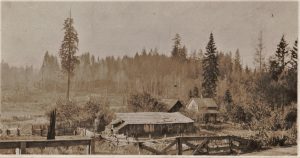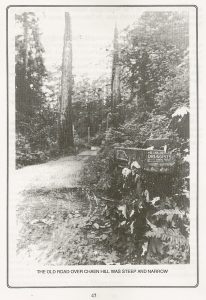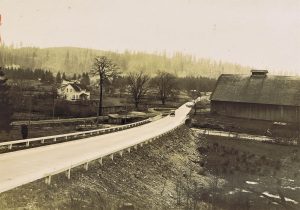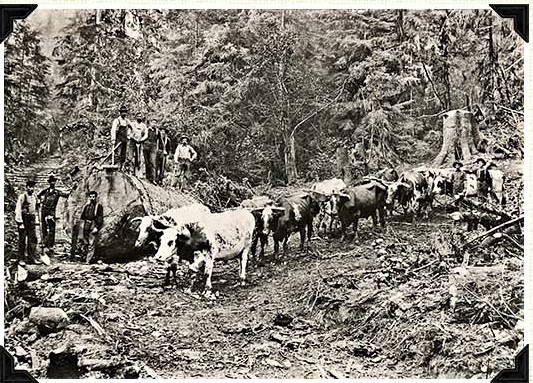Early travel into the Washington Territory took place via the Cowlitz Trail. To avoid mountain passes, hopeful pioneers moved west along the Columbia River, and loaded into canoes and barges up the Cowlitz River to Cowlitz Landing in Toledo. From there, they went overland north on the Cowlitz Prairie to Chehalis and Centralia, through Grand Mound Prairie to Tenino, and on north to Tumwater.
 Before any wagon tracks were worn into the soil, this route was traveled by Native Americans. A modern person may call the same route the Oregon Trail.
Before any wagon tracks were worn into the soil, this route was traveled by Native Americans. A modern person may call the same route the Oregon Trail.
On the last stretch of the Cowlitz Trail from Tenino to Olympia is a particularly notorious hill on Old Highway 99 called Chaenn Hill.
What’s it Called Again?
Chain Hill, as it’s often referred to today, is spelled numerous ways. I grew up on the hill and was told as a child that it was called Chain Hill because of the extra chains needed to pull the oxcarts. Alternative spellings of Chein or Chaen gave doubt to this claim.
Tenino historian Rich Edwards had family connections to Charles Chaenn, whose farm sat near Chaenn Hill. According to Edwards’ research, Charles Chaenn was born as Jean Charles Thiabaud Tschaenn in France in 1839. On July 9, 1884, Charles and his wife Zoe Chaenn purchased 80 acres from Avery Samuel Gilmore for $600. Charles went on to own a saloon in Olympia called the First and Last Chance Saloon, which was somewhere near 17th Street.

Charles and Zoe went their separate ways and eventually had a messy divorce. Charles finished out his days penniless at his farm near Tenino where he died in 1910. He sold his land to Mr. and Mrs. Wilbur Blue in exchange for their care in his declining years. A receipt that was signed by Charles clearly shows the spelling Chaenn, which is possibly an Americanized version of his birth name.
Wagons, Trains, and Automobiles
Chaenn Hill’s grade has been altered over the years. The new road, constructed about 1920, was called the Pacific Highway and is now Old Highway 99. It rerouted the ascent so the hill is less treacherous today. But at one time, the hill was both narrow and steep and well known for accidents.
Art Dwelley in his book Prairies and Quarries has this to say about the hill:
“It was a hard, lonely, and secluded life in the first years of settlement. Roads were poor and going to ‘town,’ the nearest being Tumwater, was a major project. One of the most dangerous and difficult stretches of the road was Chaen Hill. Described as a ‘terror,’ by one pioneer woman, the old road was steep and often required an extra team of oxen to negotiate. (The old wagon road was located to the east of the present highway….)”

Tenino was put on the map by Stephen Hodgden who established a stage coach or horse station at his farm referred to on the route from Olympia to the Cowlitz as Hodgden Station. The quickest route from Hodgden Farm to Olympia is over Chaenn Hill.
When the Olympia-Tenino Railroad was built, it bypassed Chaenn Hill altogether possibly because of the grade. Heading south, the train deviated away from Old 99 by Offut Lake Road toward McDuff Road, where it takes up the route of our modern BNSF railroad to Tenino. Even with this route change, the old Olympia-Tenino train ride was a notoriously bumpy ride.
But that isn’t to say that there was never a train on Chaenn Hill. More than one small spur was constructed on the top of Chaenn Hill to aid the logging companies, specifically the Olympia Logging Company and Hartson-Otis Lumber Company.
Long before the Pacific Highway or Old 99 were completed, cars took to the road in rural Thurston County. In 1914, Tenino’s streets were paved, but the paved highway didn’t arrive until around 1920, which made travel over Chaenn Hill just as treacherous for the automobile commuter. Prominent Tenino citizen William McArthur got his first car in 1913 – it was a 30 horsepower 1912 EMF touring car. His grandson, Scott McArthur humorously recounts the journey over Chaenn Hill in his book Tenino, Washington The Decades of Boom and Bust:

“The worst part of the road between Olympia and Tenino was Chaen Hill. This section of road has been realigned since then. It was a steep hill. Before the railroad came, teams hauling timber and farm goods to Olympia would double-team going up the grade. It was the scene of a number of accidents. Chaen Hill was quite a pull for the automobiles of the day. Some cars didn’t have fuel pumps. Gas flowed by gravity from the gas tank, which generally was under the front seat, to the carburetor. If the car was heading up a really steep hill, gas wouldn’t flow to the engine and the engine could stall. In that case, those people backed up the hill in reverse gear. Other cars had trouble making it with a full load. William McArthur would make the kids get out and walk up the hill while he drove. But going the other way he was afraid the mechanical brakes might fail so he would make the kids get (out) of the car and walk to the bottom of the hill where he would pick them up again.”
Between ghost trails and old railroad beds, it is easy to confuse Chaenn Hill property owners who wonder if they have a piece of the Oregon Trail running through their property. In many cases, they may have both.


















































